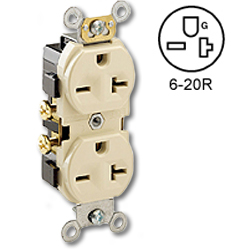Work is progressing on the shop, slowly but slowly. After several weeks of taping, mudding and sanding, I've moved to priming and painting. That means less dust but getting the gunk off my hands is now slightly more difficult (paint instead of plaster). :tinysmile_tongue_t:
Once the painting is done, it's time for the electrical. :icon_cheers
I went supply shopping this weekend, and looked among other things at 240V outlets. In my previous shop, I wired the single 240V outlet with a L6-30P receptacle. It's what my electrician recommended. It was impressive looking, for sure, but I must admit it seemed like overkill. Plus, it's pretty "fat", especially with a surface mounted outlet. And while the twist-lock is nice, I find it hard to imagine I'd accidentally unplug it by tripping. Plus, they're not cheap either.
So - what does everyone else use for their 240V/ 20A receptacles?
The second question relates to screws. When I took down the old surface-mount wiring from the previous owner, I encountered just about every type of screw that was used to mount the boxes: Wood screws flat head/ philips, wood screws flat head/ square drive (in various lengths), metal screws (pan head), button head screws, brass screws (pretty!), really long screws (3 1/2"!), undersized screws with washers, self-tapping metal screws, toggle bolts (not always easy to find the stud I suppose), screws with drywall anchors, and my personal favorite, the invisible fastener! As in a box that's just hanging loose other than some double stick tape behind it.
I was just going to use 1 1/2" #8 pan head screws, but it got me thinking. Is there a "recommended" screw for surface mounting metal boxes?
Once the painting is done, it's time for the electrical. :icon_cheers
I went supply shopping this weekend, and looked among other things at 240V outlets. In my previous shop, I wired the single 240V outlet with a L6-30P receptacle. It's what my electrician recommended. It was impressive looking, for sure, but I must admit it seemed like overkill. Plus, it's pretty "fat", especially with a surface mounted outlet. And while the twist-lock is nice, I find it hard to imagine I'd accidentally unplug it by tripping. Plus, they're not cheap either.
So - what does everyone else use for their 240V/ 20A receptacles?
The second question relates to screws. When I took down the old surface-mount wiring from the previous owner, I encountered just about every type of screw that was used to mount the boxes: Wood screws flat head/ philips, wood screws flat head/ square drive (in various lengths), metal screws (pan head), button head screws, brass screws (pretty!), really long screws (3 1/2"!), undersized screws with washers, self-tapping metal screws, toggle bolts (not always easy to find the stud I suppose), screws with drywall anchors, and my personal favorite, the invisible fastener! As in a box that's just hanging loose other than some double stick tape behind it.
I was just going to use 1 1/2" #8 pan head screws, but it got me thinking. Is there a "recommended" screw for surface mounting metal boxes?


